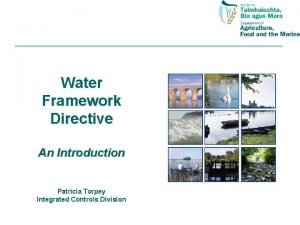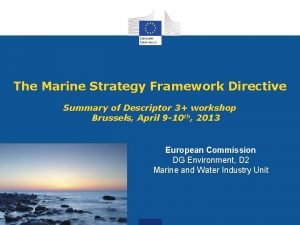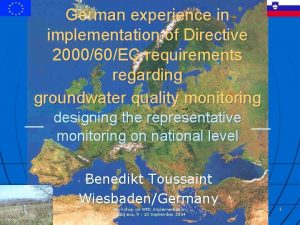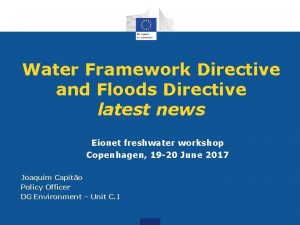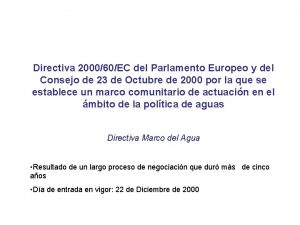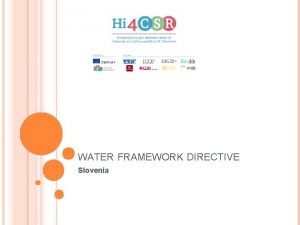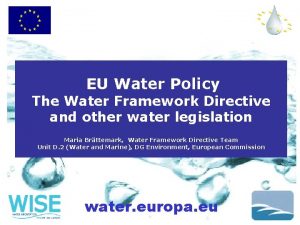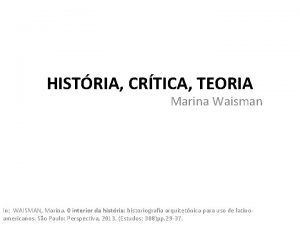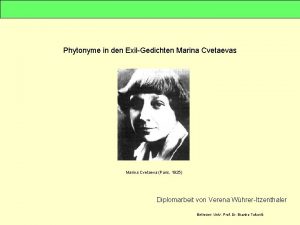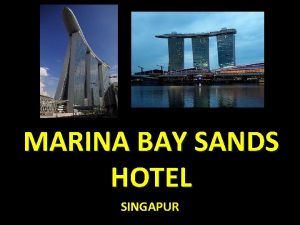The EU Water Framework Directive Directive 200060EC Marina





















- Slides: 21

The EU Water Framework Directive (Directive 2000/60/EC) Marina Tomić / IDOP (The Croatian Institute for CSR) September 2017, Brussels

Contents: Pre-History of the Water Framework Directive proposal Introduction of Water Framework Directive Aims of the Directive Co-ordination of objectives Surface water Groundwater Co-ordination of measures: Integrated river basin management Key points for national authorities Implementation in Croatia Best and worst practice examples:

Pre-History of the Water Framework Directive 1970 s: 1 st wave of EU water legislation Urban Waste Water Treatment Directive Nitrates Directive Drinking Water Directive for Integrated Pollution and Prevention Control …

Water Framework Directive proposal growing need for a single piece of framework legislation to resolve all these different problems instead of fragmented water policy rationalizing EU's water legislation by replacing seven of the "first wave" directives (streamlining legislation) expanding the scope of water protection to all waters, surface waters and groundwater achieving "good status" for all waters by a set deadline water management based on river basins getting the prices right getting the citizens involved more closely

Introduction of Water Framework Directive the Directive 2000/60/EC establishing a framework for the Community action in the field of water policy (also known as the EU Water Framework Directive) It was adopted on 23 October 2000 It has applied since 22 October 2000 EU countries had to incorporate it into national law by 22 December 2003

Aims of the Directive to halt deterioration in the status of EU’s water bodies and achieve ‘good status’ for Europe's rivers, lakes and groundwater by 2015 Specifically, this includes: protecting all forms of water (surface, ground, inland transitional) restoring the ecosystems in and around these bodies of water reducing pollution in water bodies guaranteeing sustainable water usage by individuals and businesses

Co-ordination of objectives cleaning up EU’s waters and identifying those water bodies currently at risk all Member States should aim to achieve “good status”, meaning a healthy ecosystem and low levels of chemical pollution, in all bodies of surface water and groundwater by 2015. all these objectives must be integrated for each river basin

Surface water Ecological protection “Good ecological status” - general requirement for ecological protection was introduced to cover all surface waters in terms of the quality of the biological community, the hydrological characteristics and the chemical characteristics Chemical protection a general minimum chemical standard was introduced defined in terms of compliance with all the quality standards established for chemical substances at European level

Groundwater Chemical status No minimal „allowed” level of pollution: the presumption in relation to groundwater is that it should not be polluted at all protection of groundwater from all contamination: prohibition on direct discharges to groundwater, and a requirement to monitor groundwater bodies to detect changes in chemical composition(to cover indirect discharges) Quantitative status Directive limits abstraction so that the quantity of the overall recharge is enough to support connected eco-systems

Co-ordination of measures: Integrated river basin management in international river basin districts (IRBDs) cover the territory of more than one Member State EU: a land of shared waters with about 60% of the its surface area lying in river basins that cross at least one national border management by river basin - the natural geographical and hydrological unit - instead of according to administrative or political boundaries each Member State is responsible for implementation in the portion of an IRBD lying within its territory and should coordinate these actions with the other MS in the district RBMP plans need to be updated every six years

Co-ordination of measures: Public participation Article 14 of the directive covers public information and consultation Aarhus Convention: right to environmental information) Public participation means giving the public and stakeholders the opportunity to influence the outcome of the plans and then working processes Reasons: the decisions on the most appropriate measures to achieve the objectives in the RBMP will involve balancing the interests of various groups Enforceability: the greater the transparency in the establishment of objectives, the imposition of measures, and the reporting of standards, the MS will better implement the legislation

Co-ordination of measures: Economic value of EU waters the introduction of pricing is one of the Directives's most important innovations adequate water pricing acts as an incentive for the sustainable use of water resources MS will be required to ensure that the price charged to water consumers reflects the true costs (polluters and users pay) WFD introduces two key economic principles: It calls on water users (Industries, farmers and households) to pay for the full costs of the water services they receive It calls on MS to use economic analysis in the management of their water resources and to assess both the cost-effectiveness and overall cost of alternatives when making key decisions

Co-ordination of measures: Economic value of EU waters (2) Pricing policies to address water scarcity and droughts Water scarcity: a situation where demand exceeds the level of sustainable use affects over 10% of EU’s population and almost 20% of its territory. Drought: a temporary decline in water resources due to low rainfall, the number of droughts increased has increased over the past 30 years (in 2003 they affected over 100 million people across Europe) Pricing policies to make water use more efficient

„water is not a commercial product like any other, but rather, a heritage which must be protected, defended and treated as such” Recital 1 of the Water Framework Directive

Key points for national authorities The legislation places clear responsibilities on national authorities who have to: identify the individual river basins on their territory (the surrounding land areas that drain into particular river systems) designate authorities to manage these basins in line with the EU rules analyse the features of each river basin, including the impact of human activity and an economic assessment of water use monitor the status of the water in each basin;

Key points for national authorities (2) register protected areas, such as those used for drinking water, which require special attention produce and implement RBMPs (river basin management plans) to prevent deterioration of surface water, protect and enhance groundwater and preserve protected areas ensure the cost of water services is recovered so that the resources are used efficiently and polluters pay provide public information and consultation on their river-basin management plans

Implementation in Croatia Water Framework Directive was implemented into Croatian national legislation in Water Act in 2013 The hydrographic territory of the Republic of Croatia belongs to the Adriatic Sea and Black Sea basin and is divided into two water areas: the Danube River Basin and the Adriatic Water Area The position of Croatia between the Danube (in the north) and the Adriatic Sea (in the south), and its rich freshwater resources make water management a priority in Croatia

Implementation in Croatia (2)

Best and worst practice examples: 2007 scandal: Man died after "toxic leak" at Heineken plant in Karlovac Zdravko Martinovic, 64, died after almost a month in a coma, which was allegedly induced after he breathed in carbon dioxide that is believed to have escaped from the Karlovacka Pivovara brewery in Croatia. Martinovic, a retired brewery employee, was found unconscious close to the brewery and remained in a coma until 19 March when he passed away. After an investigation, it was found that incorrectly laid pipes carried carbon dioxide gas emitted by the brewery into the sewerage system and then into the nearby Grabica stream – records suggested that this had been happening since November 2006. the leak of a huge quantity of carbon dioxide into a stream near the Brewery reduced the level of oxygen in the air

https: //www. just-drinks. com/news/man-dies-after-toxic-leak-at-heinekenplant_id 89760. aspx https: //www. analoxsensortechnology. com/blog/2016/03/15/revisiting-thekarlovac-brewery-incident/ https: //www. vecernji. hr/vijesti/karlovackoj-pivovari-3 -mil-kn-kaznedirektorima-145 -godina-zatvora-99015 Heineken Croatia in 2016: sustainability report http: //www. heineken. hr/download/HEINEKEN-Hrvatska_Sustainability. Report-2015_English. pdf

Thank you for your attention
 Tams45
Tams45 Water and water and water water
Water and water and water water Waste framework directive
Waste framework directive Eu marine strategy framework directive
Eu marine strategy framework directive Dispositional framework vs regulatory framework
Dispositional framework vs regulatory framework Theoretical framework vs conceptual framework
Theoretical framework vs conceptual framework Theoretical framework vs conceptual framework
Theoretical framework vs conceptual framework Conceptual framework theoretical framework
Conceptual framework theoretical framework Dispositional framework vs regulatory framework
Dispositional framework vs regulatory framework Conceptual framework vs theoretical framework
Conceptual framework vs theoretical framework Hát kết hợp bộ gõ cơ thể
Hát kết hợp bộ gõ cơ thể Slidetodoc
Slidetodoc Bổ thể
Bổ thể Tỉ lệ cơ thể trẻ em
Tỉ lệ cơ thể trẻ em Voi kéo gỗ như thế nào
Voi kéo gỗ như thế nào Tư thế worm breton là gì
Tư thế worm breton là gì Alleluia hat len nguoi oi
Alleluia hat len nguoi oi Các môn thể thao bắt đầu bằng tiếng bóng
Các môn thể thao bắt đầu bằng tiếng bóng Thế nào là hệ số cao nhất
Thế nào là hệ số cao nhất Các châu lục và đại dương trên thế giới
Các châu lục và đại dương trên thế giới Công thức tính độ biến thiên đông lượng
Công thức tính độ biến thiên đông lượng Trời xanh đây là của chúng ta thể thơ
Trời xanh đây là của chúng ta thể thơ
